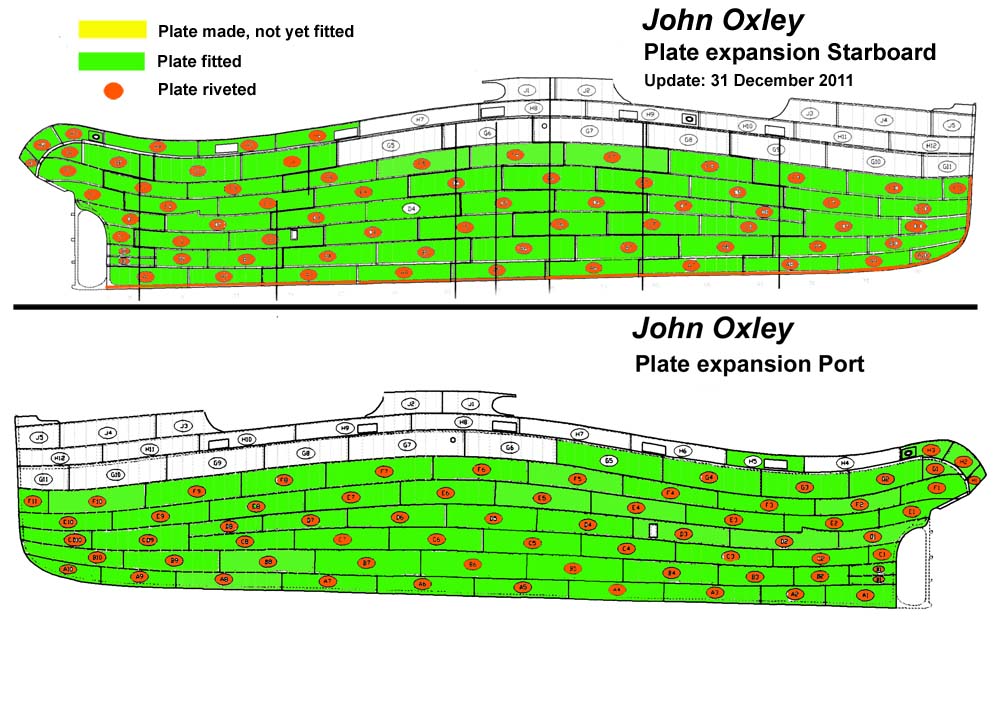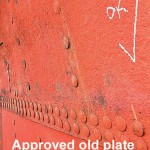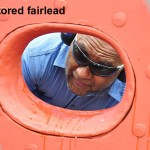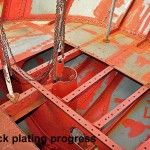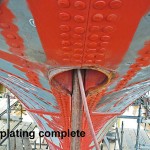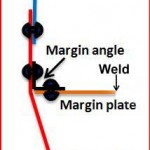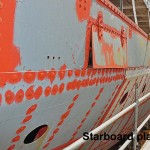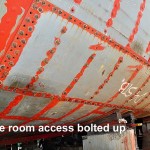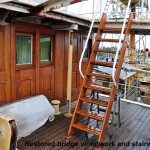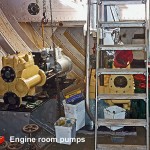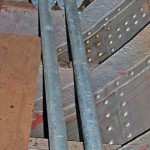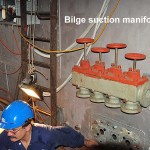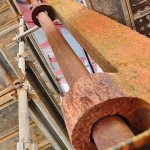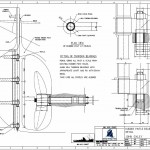John Oxley Restoration
Update January 2012
Yet another great year for John Oxley and her restoration. While the stern has taken more time than planned, the work on the aft end sheer strake and bulwarks is accelerating. Just look at the progress demonstrated in this report’s plate expansion diagram. The challenge is certainly to keep up this rate of work with materials and with workforce.
Fund raising 2012 – We have funds for our current work but a repeat of our successful 2011 fund raiser will allow us to expand some parts of the project.
Volunteers – Sydney Heritage Fleet is a volunteer organisation. Volunteering is our entire project. An oil rig maintenance manager was a recent visitor to John Oxley. He saw our machinists running lathes and mills, fabricators making new hull plates and our crews operating a tug. He mentally calculated how much our operation would cost his company if all of our volunteers were costed at commercial rates. Just 20 volunteers multiplied by a conservative $100/hr for a 6 hour day equates to a staggering $12,000/day!
Volunteers are inexpensive and extremely valuable at the same time! Volunteering is absolutely vital to everything that Sydney Heritage Fleet does. We are always seeking new volunteers and we are also asking our existing volunteers to do more and more. We need:
| • | Mast needle gunners – scaffold has been erected – need people comfortable and qualified at heights to descale and |
| paint the mast. | |
| • | Machinery space cleaners, painters – removing gear, cleaning down, painting |
| • | Engineering types to take on general work in the machinery spaces. |
| • | Hull plate caulkers – part of the fabrication team. |
| • | Fabricator skills – boiler work and piping in machinery spaces. |
| • | Leadership team – opportunity to get really involved – you can be part of the existing team, or have not yet joined up. |
| Specifically we need project leaders to assist in running the project. | |
| • | Business, promotion, fund raising and sourcing gear and materials. |
If you have any of these skills, or if you are willing to learn new skills, then please contact our office on (02) 9298 3888.
Hull
Stern – All the new hull plates of the stern are in place and riveted. The bulwark is also in place with the reconditioned hawse hole riveted in. There are a few old, original, hull plates left in place. They are situated at the lower end around the prop shaft gland.
To provide access to the stern void, one deck plate at the stern has not yet riveted in place. Some time is being spend to check that no rivets have been forgotten in nooks and crannies.
Sheer strake – We are well into the sheer strake, but like most things, there are complications. The sheer strake is connected to the hull plates below, but is also connected at the top to the deck stringer (aka margin plate). This important plate has also deteriorated due to years of exposure to sea water. There was a concrete lining over the margin plate that forms the scuppers. It affords some protection, but when this concrete is damaged, you have a serious crevice corrosion problem and the rust becomes particularly bad.
We have salvaged sheer strake plate G-4 on the port side. Only the top end, at the knuckle, has been replaced. Plate D-4 starboard has been bolted up. It covers the access from the dock to the engine room. With the removal of the sheer strake plates, it was felt that the hull would become too soft while these plates are being worked on. Once the sheer strake is completed the plate may be removed.
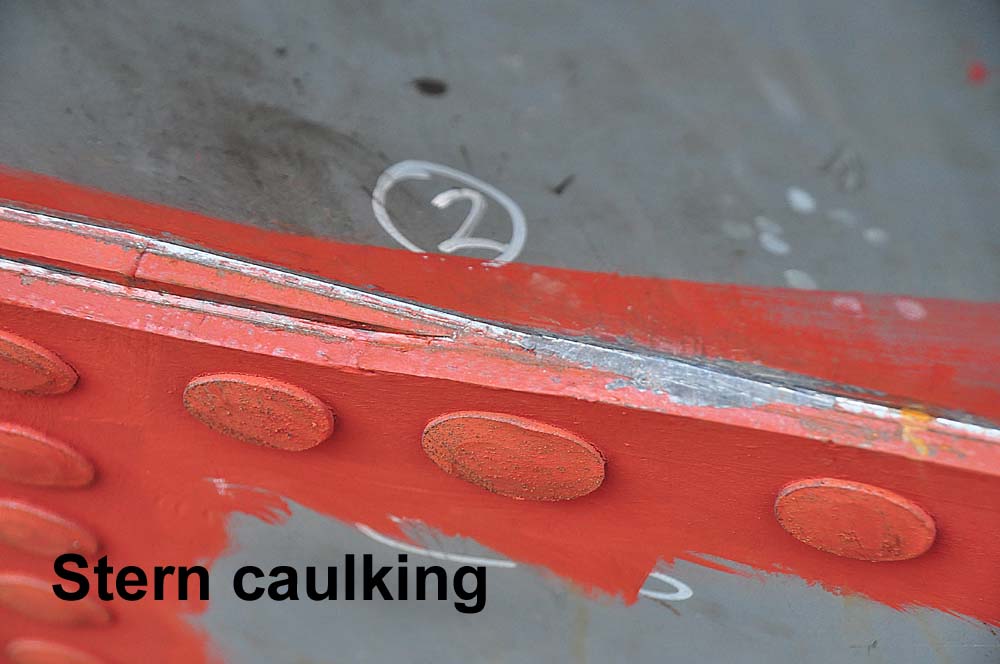 Caulking, guns and people – Caulking of the stern plates has started. This is difficult work and requires a medium sizes but powerful air hammer with a squared off chisel point that is driven down parallel to the face of each plate seam to drive the steel of a seam edge into its adjoining plate face. See also “How it is Done“
Caulking, guns and people – Caulking of the stern plates has started. This is difficult work and requires a medium sizes but powerful air hammer with a squared off chisel point that is driven down parallel to the face of each plate seam to drive the steel of a seam edge into its adjoining plate face. See also “How it is Done“
The result is a watertight joint that will initially withstand a test from a fire hose without leakage. In practice, some small leaks are often present, but these usually take up and stop leaking after a couple of days.
Caulking is an arduous task and not looked forward to by the fabrication team, particularly the seams where the air hammer must be worked upwards into the seam.
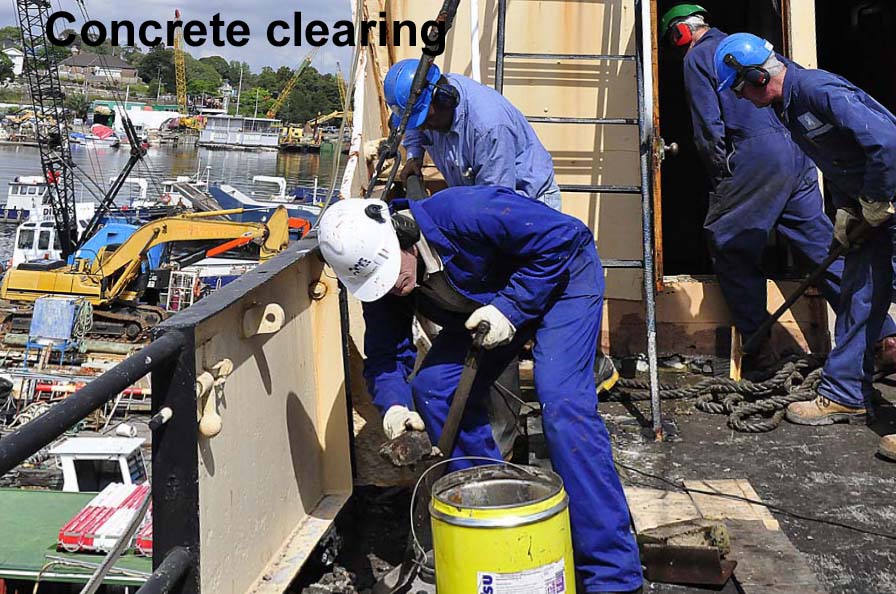 Clearing concrete on the margin plate – In preparation for margin plate (or deck stringer) work, the scuppers and the crew wash space forward have to be cleared of concrete. This was achieved with jack hammers and needle guns in the hands of volunteers.
Clearing concrete on the margin plate – In preparation for margin plate (or deck stringer) work, the scuppers and the crew wash space forward have to be cleared of concrete. This was achieved with jack hammers and needle guns in the hands of volunteers.
Removal of this concrete is required so that the oxy cutters torches can get through to the steel of the margin plate and blow the rivets.
Margin Plate – The margin plate, also known as the deck stringer, is an important structural member of the hull. It must be in good condition, but as on most seagoing ships, the inevitable salt water causes serious rusting and wastage. John Oxley is no exception here, and substantial margin plate repairs are needed.
Bridge woodwork – The teak deck house and stairways have been redone. All woodwork exposed to the elements need constant maintenance and the work done on these parts of the ship are a tribute to the shipwrights.
Machinery
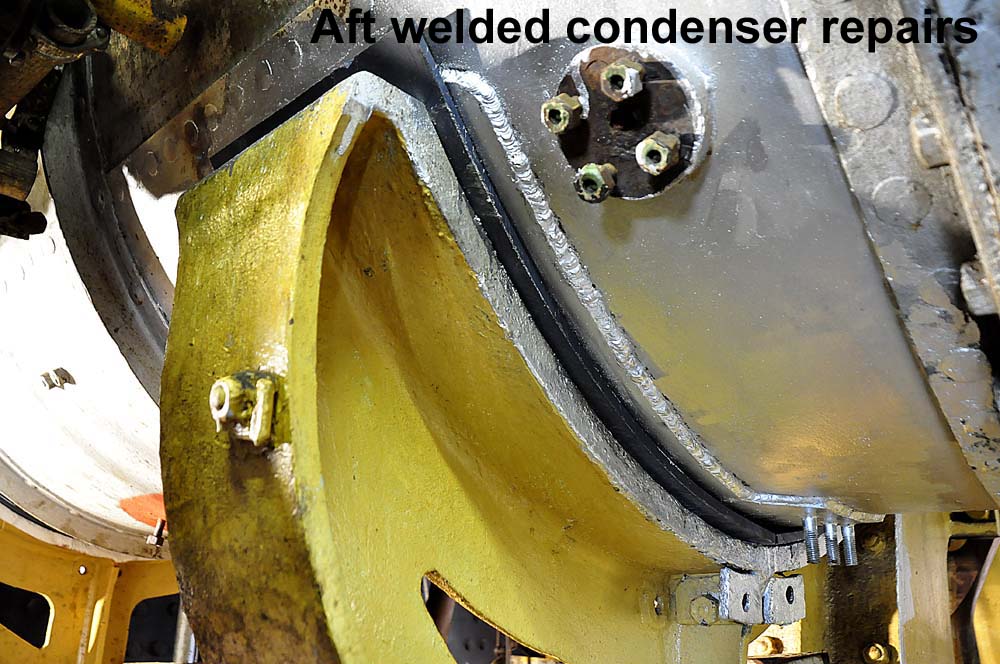 Condenser – Welding and mounts – Ian and Brian have finished the repair to the condenser aft shell where it rests on its support cradle. Next task will be to secure each end, fit blanking plates to all condenser openings and then undertake a low air pressure bubble test with soapy water to locate and fix any condenser leaks. Even a low pressure air test imposes a few tons of force on the condenser end plates and it is important that sufficient securing bolts are fitted to withstand this load.
Condenser – Welding and mounts – Ian and Brian have finished the repair to the condenser aft shell where it rests on its support cradle. Next task will be to secure each end, fit blanking plates to all condenser openings and then undertake a low air pressure bubble test with soapy water to locate and fix any condenser leaks. Even a low pressure air test imposes a few tons of force on the condenser end plates and it is important that sufficient securing bolts are fitted to withstand this load.
The large and heavy aft condenser water box has been craned on board for a trial fitting. Unfortunately a mismatch on some holes could not be adjusted in the engine room and this component has gone back to the workshop. It will be returned to the condenser and bolted in place when this work is done to test for condenser leaks.
Bilge pumps and systems – The duty steam pump, a Worthington horizontal duplex, is installed. This pump has a bronze pump end and will become the duty pump.
The other pump now waiting its connections is the original Dawson and Downie general service pump. This pump is on board, but temporarily moved away so it is not in the way of the condenser work.
Work continues in the boiler space and forward compartments on the installation of pre-made bilge suction and ballast system straight lengths. When these are in place, flanges, pipes and bends will be added and tack welded together. They will then be welded ashore, galvanised and installed.
Of interest to marine and engineering readers was the original bilge suction system, which consisted of 6 foot lengths of 3″ (75 mm.) bore flanged cast iron pipes that were bolted together. To connect these straight lengths, lead pipes were fashioned into bends to flexibly connect the rigid cast iron pipes. Today, lead suction pipes are not accepted by the code and galvanised steel or copper suction pipes are required.
This work is being carried out by our fabrication team – we owe much to this team, who over the years have carried out so much work on all parts of John Oxley and other Sydney Heritage Fleet vessels.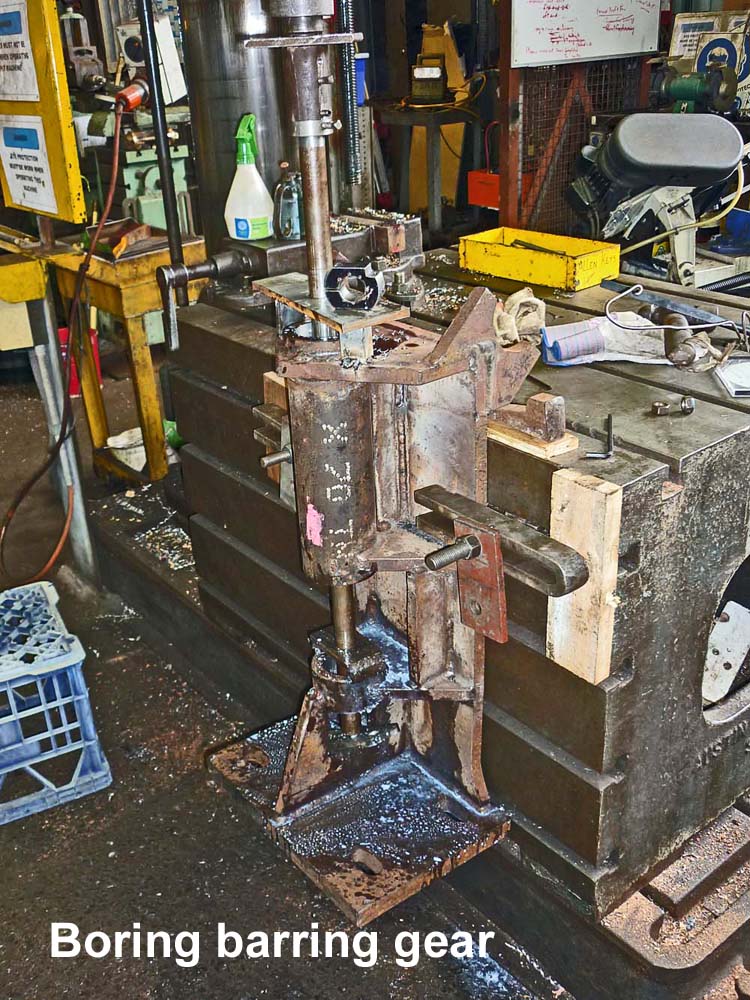
Barring gear – The barring gear is a worm and gear mechanism that rotates the main engine for maintenance and can lock the main engine for safety. The original cast iron frame was badly cracked and a specialised welded repair was attempted, but subsequent non-destructive testing showed cracks.
Earlier repair welds also showed extensive cracks. This part must be safe, so a welded replacement was started. Steel was cut and welded into position and the various bores were machined using our faithful old radial drill set up as a vertical borer. Gears and worm shafts are now being installed.
The barring gear is needed to turn the propeller shaft line for in-situ machining on the extremity of the prop shaft. This is required to seat a new oil tight shaft seal.
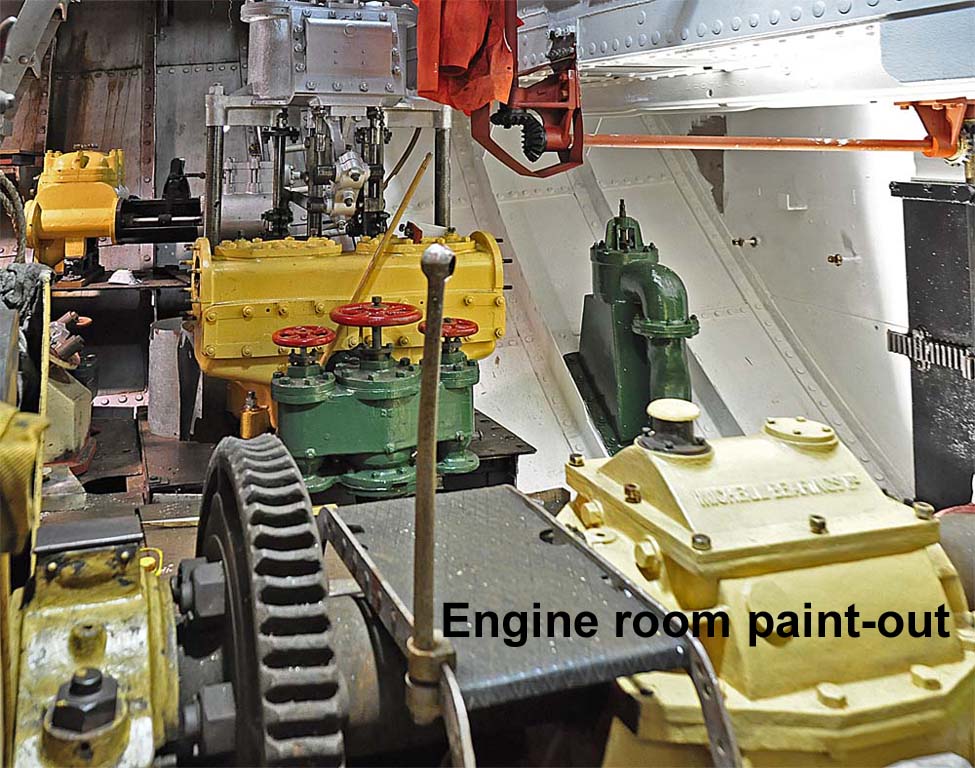 Painting out engine room – The engineers were keen to complete the starboard aft section and paint out this space to show what the engine room will look like when complete. This part of the ship is almost complete with only some minor work required.
Painting out engine room – The engineers were keen to complete the starboard aft section and paint out this space to show what the engine room will look like when complete. This part of the ship is almost complete with only some minor work required.
Like most engine rooms, John Oxley’s machinery space is finished in white gloss. Machinery is being painted pale ochre to match one of the two paint schemes discovered through scraping. The earlier colour was a mid-green, but the “Hand over Configuration” pale ocher scheme was chosen as the final finish.
Piping colours will match the older heritage colour code as follows:
| • | Steam and exhaust – white lagging with silverfrost flanges |
| • | Seawater – mid green |
| • | Freshwater – blue |
| • | Fire – bright red |
| • | Bilge – black |
| • | Oil – brown |
These colours are standardised throughout our engine rooms to assist crews.
Rudder alignment – An alignment mandrel has been inserted down through the rudder mountings so that the fabrication team can install the steel plates for the rudder head bearing.
Drafting – Many new drawings are needed for piping diagrams and for rudder and propeller shaft details. These are being produced as needed by volunteer engineer Glenn Rigden who is a proficient Autocad user. One of the drawings is currently being used to assemble new rudder pintles and bushes into the stern frame.
Project review end 2011
Late in 2011, the SHF Board requested an updated report from the John Oxley team on their expectations regarding future restoration and utilisation options for John Oxley. This has been a comprehensive exercise, but it is worthwhile visiting this aspect of restoration from time to time.
Most important is the preservation and communication of John Oxley as a record of coastal steamships and its national heritage to the public. It demands a display activity. Sydney Heritage Fleet also places a high importance on operational ships, in order that its vessels are seen “live” and that the skill sets needed to maintain and operate marine steam engines and boilers are preserved.
This requires a mix of possible utilisations that include conventional museum display alongside, but also a display in operating form to a much wider general public and media when out and about on Sydney Harbour and beyond, and to professionals on nearby vessels, plus our volunteers who crew the vessel in static and operational form.
The restoration team plans and works to a high quality and highly authentic restoration plan using appropriate materials and techniques to “future proof” the restoration, and to avoid premature restoration failure.
Sponsors and supporters
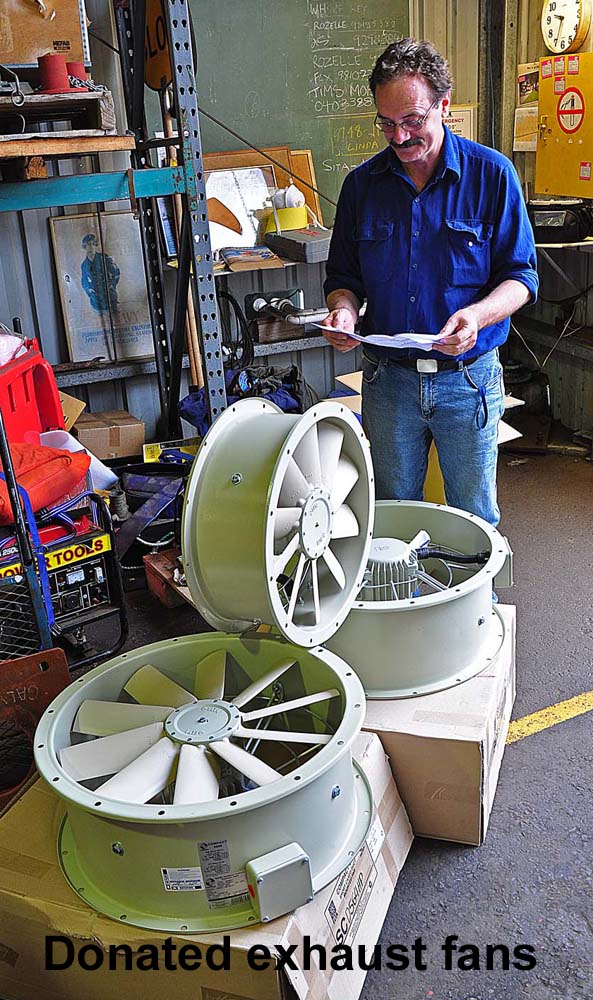 Most tools and consumables are sponsored. The project is fortunate to enjoy considerable assistance from business and industry. We work hard to maximise our project ethic, hence volunteering, social capital, apprentices, preserving heritage, links with government, business and industry and maximised use of all resources are critical project aims.
Most tools and consumables are sponsored. The project is fortunate to enjoy considerable assistance from business and industry. We work hard to maximise our project ethic, hence volunteering, social capital, apprentices, preserving heritage, links with government, business and industry and maximised use of all resources are critical project aims.
It is safe to say that every dollar spent and all materials bought or donated are used carefully and with negligible waste. Even scraps of steel are used to make pipe flanges and brackets; you just do not see new steel scraps in our recycling bin! More support from business and industry is sought.
| • | At the moment, we are seeking donation of steel for structure and plating. We are soon |
| to commence deck plates, and will need a lot of steel for that. | |
| • | As the bilge piping system progresses, we need a few 80 mm. 415 volt electric pumps |
| to complement the system when John Oxley is not in steam. | |
| • | 13/16″ and 11/16″ drills and tapered reamers are not cheap – they wear out and must |
| be purchased. Other drill sizes are also sought. | |
| • | General tools such as oxy gear, needle guns and air hoses are also sought. Add to this |
| welding consumables and equipment. |
If you are able to provide any of these, then please contact Tim at the worksite, or call the office on (02) 9298 3888.
A big thank you from all of the volunteers
To visit the project or help with materials or services, contact our office on (02) 9298 3888 or drop in on the project and ask to see Tim Drinkwater or one of the John Oxley team.
Book release
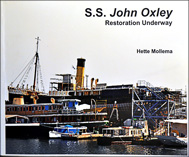 A book on the restoration of the John Oxley is now available via an on-line publisher. If you have had any association with the ship then this book is a must. Read the summary and review
A book on the restoration of the John Oxley is now available via an on-line publisher. If you have had any association with the ship then this book is a must. Read the summary and review
